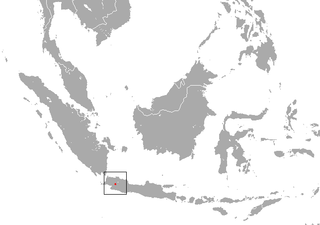
A species that is extinct in the wild (EW) is one that has been categorized by the International Union for Conservation of Nature as known only by living members kept in captivity or as a naturalized population outside its historic range due to massive habitat loss.

The Somali hedgehog is a species of mammal in the family Erinaceidae. It is endemic to Somalia and Somaliland. The Somali hedgehog is nocturnal.

The Oriental shrew is a species of mammal in the family Soricidae. It is endemic to Indonesia.

The pale gray shrew is a species of mammal in the family Soricidae. It is endemic to Pakistan and is distributed in the Shigar valley and the western edge of Deosai.

Portenko's shrew is a species of mammal in the family Soricidae that is endemic to Russia.

The Lowe's shrew is a species of mammal in the family Soricidae. It is found in China, Myanmar, Thailand, and Vietnam.
Speleoperipatus is a monospecific genus of velvet worm in the Peripatidae family, containing the single species Speleoperipatus spelaeus. This species is a pale greenish yellow, almost white, with 22 or 23 pairs of legs and no eyes. Specimens range from 27 mm to 34 mm in length. The minimum number of leg pairs found in this species (22) is also the minimum number found in the neotropical Peripatidae. This velvet worm is viviparous, with mothers supplying nourishment to their embryos through a placenta.

Cupedora broughami is a species of air-breathing land snail, a terrestrial pulmonate gastropod mollusk in the family Camaenidae. This species is endemic to Australia.
Cupedora luteofusca is a species of air-breathing land snail, a terrestrial pulmonate gastropod mollusk in the family Camaenidae. This species is endemic to Australia.
Cupedora marcidum is a species of air-breathing land snail, a terrestrial pulmonate gastropod mollusk in the family Camaenidae, and is endemic to Australia.
Cupedora nottensis is a species of air-breathing land snail, a terrestrial pulmonate gastropod mollusk in the family Camaenidae. This species is endemic to Australia.
Cupedora sutilosa is a species of air-breathing land snail, a terrestrial pulmonate gastropod mollusk in the family Camaenidae. This species is endemic to Australia.
Cupedora tomsetti is a species of air-breathing land snail, a terrestrial pulmonate gastropod mollusk in the family Camaenidae. This species is endemic to Australia.

Stygobromus is a genus of amphipod crustaceans that live in subterranean habitats. The majority of the listed species are endemic to North America, a smaller number of species are also known from Eurasia. Most of the North American species live in areas which were not covered by the Laurentide Ice Sheet, although a few species seem to have survived under the ice. A number of species are on the IUCN Red List as endangered species (EN) or vulnerable species (VU); one species, S. lucifugus, is extinct.
The small Samoan flying fox is a species of fruit-eating megabat whose type specimen was originally collected in Samoa in 1856, but was not identified as a new species until 2009. Its wingspan was at least two feet, and it weighed around 8 oz. As the type specimen is dead, and no other examples of the species are known, it is believed to be extinct.

Haplocheirus is a genus of theropod dinosaur. Upon its description, it was considered the oldest alvarezsauroid, predating all other members by about 63 million years. This has subsequently been questioned. A 2019 study considered Haplocheirus a compsognathid instead of an alvarezsauroid, while a 2022 study considered it to have more similarities with ornithomimosaurs. Haplocheirus was described in 2010 from a fossil specimen found from the 160-million-year-old Shishugou Formation in the Junggar Basin of northwestern China. The type species is H. sollers, meaning "simple-handed skillful one", referencing its hypothesized behavior of using its three-fingered hands for activities that other alvarezsauroids could not perform, such as catching prey.

NGC 5965 is a spiral galaxy located in the constellation Draco. It is located at a distance of circa 150 million light years from Earth, which, given its apparent dimensions, means that NGC 5965 is about 260,000 light years across. It was discovered by William Herschel on May 5, 1788. Two supernovae have been observed in NGC 5965, SN 2001 cm and SN 2018cyg.










